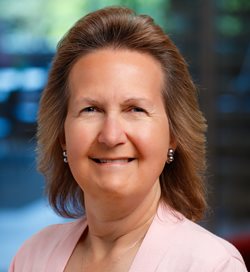The 2019 Rosalind Kornfeld Award for Lifetime Achievement in GlycobiologyDonald L. Jarvis1 The Rosalind Kornfeld Award for Lifetime Achievement in Glycobiology was established in 2008 to honor the distinguished scientific career and service to the Society by Dr. Rosalind Kornfeld. The award is given by the Society to scientists who have made significant contributions with an important impact on the field of Glycobiology over their professional lifetimes.
In 1989, Dr. Dahms began her independent career as Assistant Professor of Biochemistry at the Medical College of Wisconsin. Recognizing the importance of understanding how the MPRs bind Man-6-P-containing glycans, she had the courage to undertake the arduous task of determining the structure of the Man-6-P binding domains of these receptors. In a seminal Cell paper in 1998, in collaboration with Dr. Jung-Ja Kim, Dr. Dahms published the three-dimensional structure of the Man-6-P binding domain of the CD-MPR, providing the first insight into the mechanism of Man-6-P binding to the receptor. This was followed by structural studies of the CI-MPR, which has 15 repetitive domains in its extracellular region, as compared to only one for the CD-MPR. She discovered 4 of the 15 repeats bind Man-6-P. Two bind Man-6-P monoesters, one binds a Man-6-P-GlcNAc diester, and one binds both. Nancy identified the key residues within the binding pocket that interact with the mannose ring and phosphate and clarified the molecular basis for the difference in the ability to bind phosphodiesters. Another of Dr. Dahms’ major contributions has been her studies of the Man-6-P receptor homology (MRH) domain of the eta-subunit of the ER enzyme, glucosidase II (GII). The MRH domain of GII shows homology to domains found in a family of ER proteins that function as mannose-binding lectins as well as to the Man-6-P binding domains of the Man-6-P receptors. In collaborative studies with Dr. Cecilia D’Alessio in the Parodi lab, Dr. Dahms elucidated the complete structure of the GII MRH domain in both mannose bound and unbound states. This provided insight into how this MRH domain recognizes and binds carbohydrate ligands. Dr. Dahms has generated the first non-mouse model of the LSD, Fabry disease. Fabry disease is caused by a deficiency of the acid hydrolase, α-galactosidase A, which leads to glycosphingolipid accumulation in many cell types. Unlike Fabry mouse models, this α-galactosidase A-deficient rat recapitulates ocular, hearing, heart and pain phenotypes experienced by Fabry patients. Fabry rats are being used to study disease mechanisms and test new therapies. Together, these studies have greatly advanced our understanding of how the MPRs function in acid hydrolase transport and also how the MRH-containing lectins facilitate glycoprotein folding in the ER. Dr. Dahms has written the definitive reviews of this topic for major scientific journals. Her publications are models of careful and well executed research that is clearly presented. Dr. Dahms’ service to the Medical College of Wisconsin has been exceptional, especially in terms of teaching and mentoring. She has been recognized as the Outstanding Medical Student Teacher 8 times and has received the Outstanding Faculty Service Award 3 times. She also has received the Outstanding Graduate Student Teacher Award. She has served on the Ph.D. thesis committee of 50 graduate students and advised numerous post-doctoral students and junior faculty. Dr. Dahms has been active in the Society for Glycobiology for many years. Dr. Dahms served on the Board of Directors from 2003-2006 and again from 2017-2020. She was a member of the Nominations Committee from 2011-2012. She also has served on the Editorial Boards of Glycobiology and the Journal of Biological Chemistry. Based on the high impact of her research, her service to the field, and her high standards of scholarship, Dr. Dahms is a highly deserving recipient of the Rosalind Kornfeld Award for Lifetime Achievement in Glycobiology. |

 The 2019 Rosalind Kornfeld Award will be presented to Dr. Nancy Dahms, Professor in the Department of Biochemistry at the Medical College of Wisconsin. Dr. Dahms, a native of Wisconsin, received her B.S. degree from Marquette University in Milwaukee. She then entered graduate school at Johns Hopkins University where she earned her Ph.D. in Biochemistry working in the lab of Gerald Hart and was introduced to glycobiology studying the nature of glycans on several plasma membrane glycoproteins. Nancy then undertook her postdoctoral training in Stuart Kornfeld’s lab at Washington University in St. Louis where, along with Peter Lobel, another postdoc, she succeeded in cloning the cDNAs for the two mannose 6-phosphate receptors, the cation-independent (CI-) and cation-dependent (CD-) MPRs. These receptors play a central role in the transport of newly synthesized acid hydrolases from the Golgi to the lysosome. Most of the FDA-approved treatments for Lysosomal Storage Diseases (LSDs) involve enzyme replacement therapy that target the CI-MPR for the uptake of recombinant acid hydrolases.
The 2019 Rosalind Kornfeld Award will be presented to Dr. Nancy Dahms, Professor in the Department of Biochemistry at the Medical College of Wisconsin. Dr. Dahms, a native of Wisconsin, received her B.S. degree from Marquette University in Milwaukee. She then entered graduate school at Johns Hopkins University where she earned her Ph.D. in Biochemistry working in the lab of Gerald Hart and was introduced to glycobiology studying the nature of glycans on several plasma membrane glycoproteins. Nancy then undertook her postdoctoral training in Stuart Kornfeld’s lab at Washington University in St. Louis where, along with Peter Lobel, another postdoc, she succeeded in cloning the cDNAs for the two mannose 6-phosphate receptors, the cation-independent (CI-) and cation-dependent (CD-) MPRs. These receptors play a central role in the transport of newly synthesized acid hydrolases from the Golgi to the lysosome. Most of the FDA-approved treatments for Lysosomal Storage Diseases (LSDs) involve enzyme replacement therapy that target the CI-MPR for the uptake of recombinant acid hydrolases.